This post is the fifth in our series about myFutureNC’s Bite-Sized Webinars. Previous posts covered Family-Sustaining Wages, Labor Market Alignment, FAFSA and Financial Aid, and NC Pre-K.
Top Opportunities for Growth
In this post we will be discussing the fifth Bite-Sized Webinar from myFutureNC, which focused on the Top Opportunities for Growth. For this topic, the data are not directly available from myFutureNC for our region as a whole, so we will be addressing the county-level data for our four counties (Buncombe, Henderson, Madison, and Transylvania) first and then combining that data to identify the Top Opportunities for Growth for our region as a whole.
Gina Zhang, myFutureNC’s Research and Data Manager, facilitated this Bite-Sized Webinar on April 30, 2024. Ms. Zhang drew viewers’ attention to the Top Opportunities for Growth section on the front page of the NC state attainment profile. For the state of NC as a whole, the Top Opportunities for Growth are Math Performance, NC Pre-K Enrollment, and FAFSA Completion, which were the top opportunities for growth for 40, 38, and 37 counties in the state, respectively.
How Are Top Opportunities for Growth Identified?
Nathan Dollar, Executive Director of Carolina Demography, led the data deep dive section of this webinar. He began by explaining the process used to determine each county’s Top Opportunities for Growth. First, myFutureNC tracks each county’s performance on 13 indicators, as shown in the slide below.
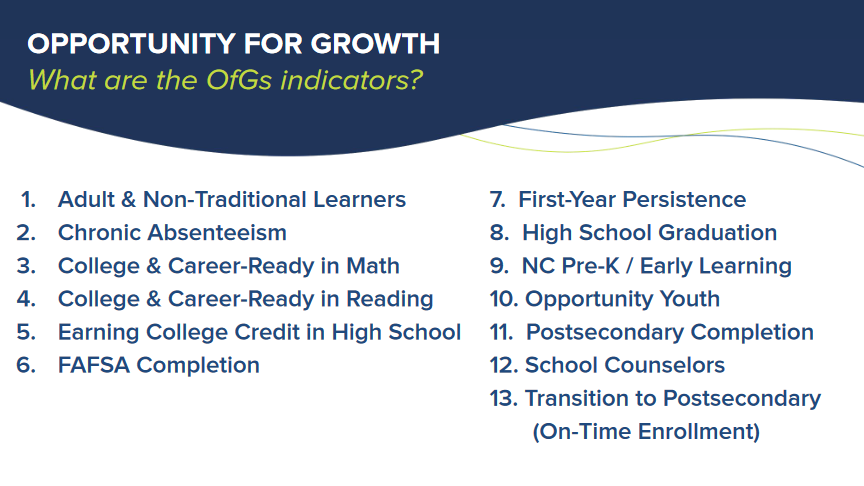
Next, a county’s performance on each indicator is compared to the performance of its peer counties for the same indicator. Peer counties are those in the same rural/urban category (such as urban, suburban, and rural non-metro) using the classification system of the NC Rural Center. The three biggest gaps between a county’s performance and the average performance of its peer counties are identified as that county’s Top Opportunities for Growth. If this process did not result in three Top Opportunities for Growth, then the county’s performance was compared to the state’s. For each county, these three areas represent the biggest opportunities to improve future attainment outcomes.
Best Practice of Using the Top Opportunities for Growth
In this section of the webinar, Pamela Gould, Executive Director of the Strategic Twin-Counties Educational Partnership (STEP), spoke about her organization’s successful utilization of the Top Opportunities for Growth to drive action and improve performance in the two counties they serve. Although one of the non-profit’s primary focus areas since its inception has been workforce readiness, they realized after seeing their Top Opportunities for Growth that they needed to pivot to focusing on the low literacy rates in their two counties. Armed with the data, they were able to mobilize a coalition of local government and other partners to implement two initiatives aimed at improving literacy rates.
Top Opportunities for Growth in the Land of Sky Region by County
Using the rural/urban classification system of the NC Rural Center, two of the counties in the Land of Sky region are suburban (Buncombe and Henderson), and two are rural (Madison is rural – metro, and Transylvania is rural – non-metro). Let’s first look at each county’s Top Opportunities for Growth according to the 2024 attainment profiles. Then we’ll discuss each county’s progress on its Top Opportunities for Growth by comparing data from the 2020, 2022, and 2024 attainment profiles.
Buncombe County (suburban)
The Top Opportunities for Growth for Buncombe County (outlined in red in the image below) are FAFSA Completion, NC Pre-K Enrollment, and Transition to Postsecondary. FAFSA Completion performance was compared to the average of peer counties, while NC Pre-K Enrollment and Transition to Postsecondary performance were compared to the state average.
FAFSA Completion
Buncombe County’s FAFSA Completion rate for high school seniors is 60%, which is 2% below the average rate (62%) of the other suburban counties in the state. Our 2030 FAFSA Completion goal is for 80% of high school seniors to complete the FAFSA. Buncombe County is currently 20% below this goal.
NC Pre-K Enrollment
Only 46% of eligible four-year-olds in Buncombe County are enrolled in NC Pre-K, compared to the state average of 53%. This difference represents a 7% gap. Our 2030 NC Pre-K Enrollment goal is for 75% of eligible four-year-olds to be enrolled in NC Pre-K. Buncombe County is 29% below this goal.
Transition to Postsecondary
Buncombe County is 5% below the state average for the Transition to Postsecondary indicator. Only 53% of Buncombe County’s high school seniors enroll in postsecondary education within 12 months of graduation, compared to the state average of 58%. Buncombe County is 12% below our 2030 Transition to Postsecondary goal of 65% of high school graduates to enroll in a postsecondary institution within 12 months of graduation.
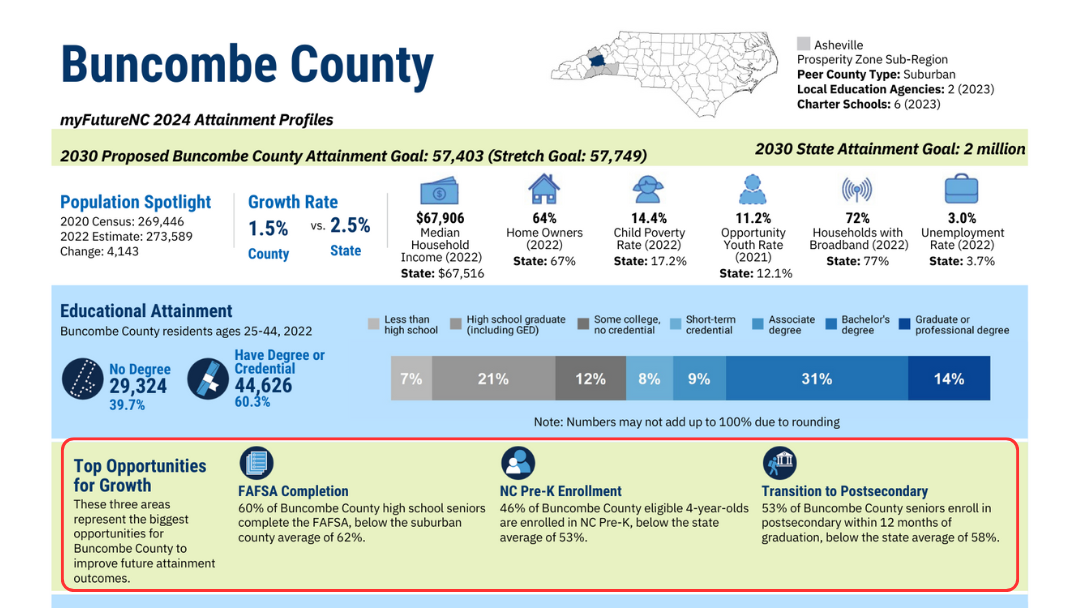
Buncombe County's Progress on Top Opportunities for Growth
Because two of the three Top Opportunities for Growth for Buncombe County–NC Pre-K Enrollment and Transition to Postsecondary–have been the same for all three attainment profiles (2020, 2022, and 2024), we can track trends in these indicators over time. The chart below shows the county’s progress in these two areas. NC Pre-K Enrollments have continually increased: from 35% on the 2020 attainment profile, to 41% on the 2022 attainment profile, and then to 46% on the 2024 attainment profile. The Transition to Postsecondary indicator declined from 58% on the 2020 attainment profile to 51% on the 2022 attainment profile and then rebounded to 53% on the 2024 attainment profile. The third indicator has varied from one year’s attainment profile to the next, so no comparisons can be made.
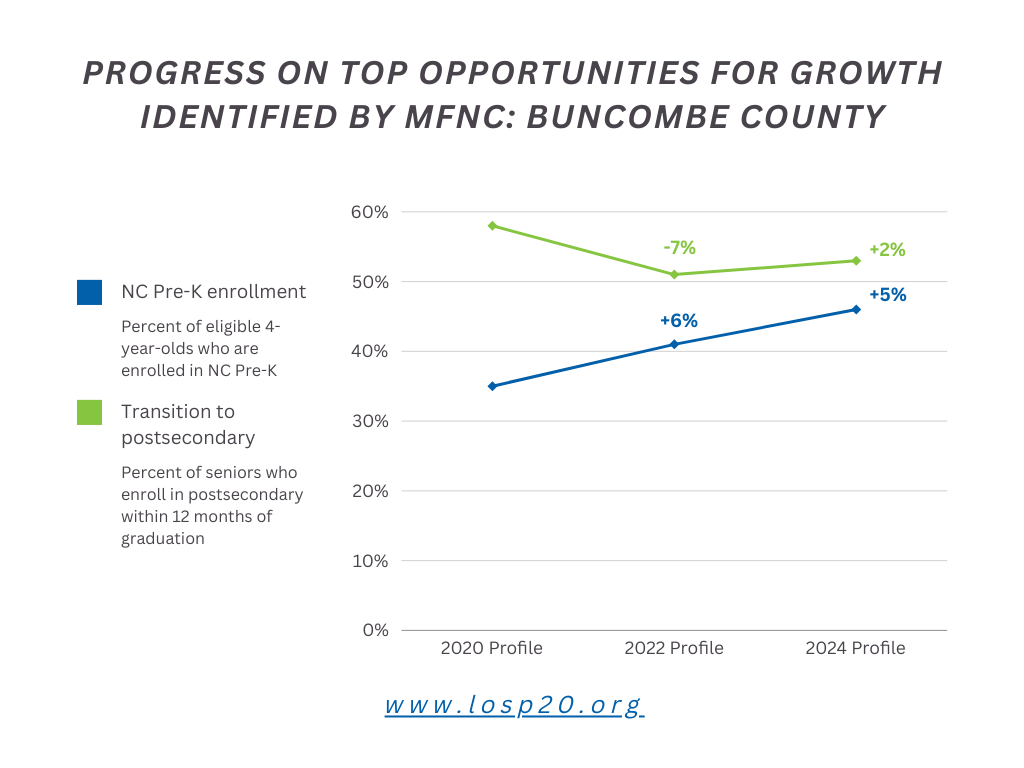
Henderson County (suburban)
Henderson County’s Top Opportunities for Growth (outlined in red in the image below) are NC Pre-K Enrollment, Adult Learners, and Earning College Credit in High School. The county’s performance on all three indicators was compared to the average performance of its peer counties.
NC Pre-K Enrollment
Henderson County’s NC Pre-K enrollment rate of 28% of eligible four-year-olds is 17% below the average NC Pre-K enrollment rate of its peer counties (45%). Henderson County is 47% below our 2030 NC Pre-K Enrollment goal of 75% of eligible four-year-olds being enrolled in NC Pre-K.
Adult Learners
In Henderson County, the percentage of adults ages 25-44 who have some college but no degree (18%) is 3% higher than the average of its peer counties (15%). When combined with the percentage of adult learners who have less than a high school education (9%) and those whose highest educational attainment was the completion of high school whether by graduating or earning a GED (25%), 52.5% of Henderson County’s adults ages 25-44 have no degree or credential. Put another way, 47.5% do have a degree or credential. This educational attainment rate is 14.5% below the 2030 educational attainment goal for Henderson County (62%) that was set by myFutureNC.
Earning College Credit in High School
Only 13% of Henderson County high school students took at least one AP exam, below the suburban county average of 15%. Also, 39% of graduates participated in the Career & College Promise programs, which matches the peer county average of 39%.
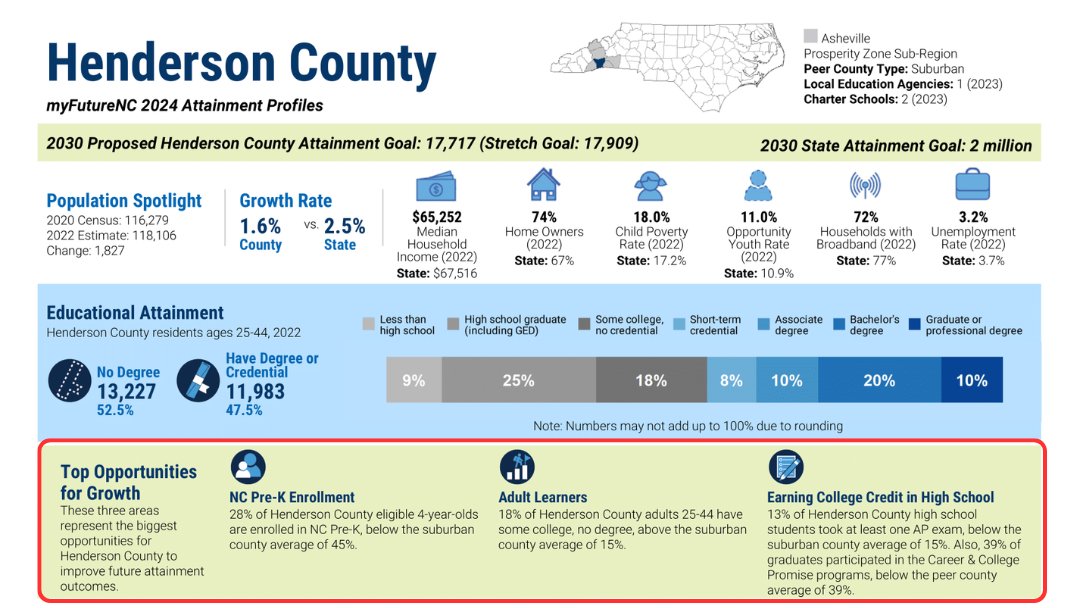
Henderson County's Progress on Top Opportunities for Growth
For Henderson County, NC Pre-K Enrollment was identified as one of the Top Opportunities for Growth on both the 2020 and 2024 attainment profiles. On the 2020 profile, the county’s NC Pre-K Enrollment rate was 35%. On the 2022 profile, the rate had increased 14%, with 49% of eligible four-year-olds in the county enrolled in NC Pre-K, and this progress on the indicator meant that it did not meet the criteria to be a Top Opportunity for Growth. On the 2024 profile, enrollments had declined to 28%, a decrease of 21%. The net change from the 2020 profile to the 2024 profile was a decrease of 7% in NC Pre-K enrollments in the Henderson County.
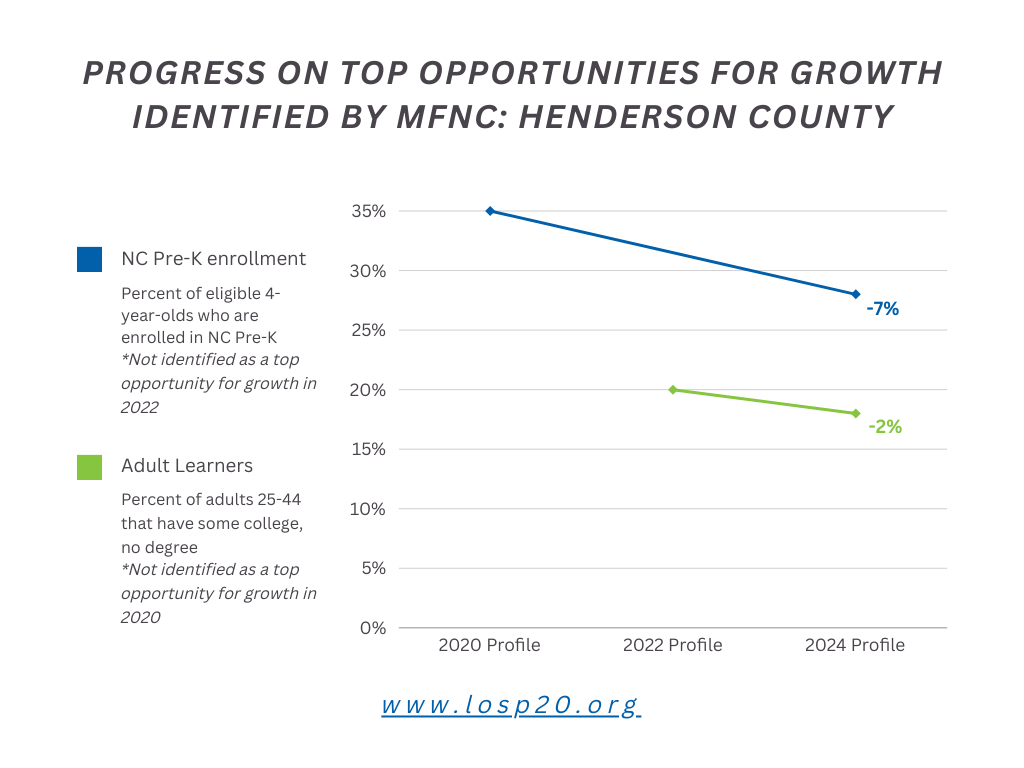
Madison County (rural - metro)
In Madison County, the Top Opportunities for Growth (outlined in red in the image below) are FAFSA Completion, NC Pre-K Enrollment, and Chronic Absenteeism. For all three indicators, the county’s performance was compared to the average performance of its peer counties.
FAFSA Completion
In Madison County, 50% of high school seniors complete the FAFSA, which is 8% below the rural – metro county average of 58%. Madison County’s FAFSA Completion rate of 50% is 30% below our 2030 FAFSA Completion goal of 80%.
NC Pre-K Enrollment
Madison County enrolls 55% of its eligible four-year-olds in NC Pre-K, which is 4% below the rural – metro county average of 59%. Madison County’s NC Pre-K Enrollment rate of 55% is 20% below our 2030 NC Pre-K Enrollment goal of 75%.
Chronic Absenteeism
Madison County students have a chronic absenteeism rate of 31%, which is 2% higher than the rural – metro county average of 29%. The Land of Sky P20 Council does not have a 2030 goal pertaining to Chronic Absenteeism; however, myFutureNC does. Their Chronic Absenteeism goal for 2030 is for 11% of K-12 students to miss 10% or more of school days. The Chronic Absenteeism rate for the state of NC is currently 31%.
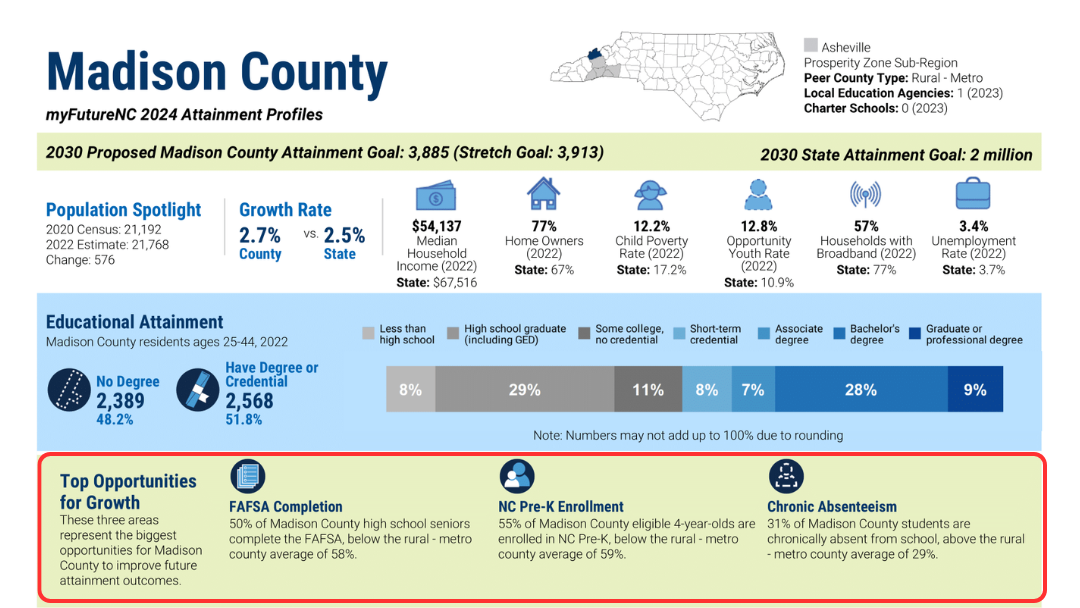
Madison County's Progress on Top Opportunities for Growth
Transition to Postsecondary was identified as a Top Opportunity for Growth on the 2020 and 2022 attainment profiles only, and FAFSA Completion was identified as a Top Opportunity for Growth only on the 2022 and 2024 attainment profiles. NC Pre-K Enrollments have consistently increased over this time, rising 10% from the 2020 profile to the 2022 profile and then rising an additional 3% on the 2024 profile, to the current rate of 55%. Conversely, Transition to Postsecondary rates have consistently declined: from 45% on the 2020 profile to 38% on the 2022 profile and then to 34% on the 2024 profile, a total decrease of 11%. Progress on FAFSA Completion rates during this time has been mixed. Rates initially rose from 47% on the 2020 profile to 52% on the 2022 profile but then declined to 50% on the 2024 profile, for a net increase of 3%.
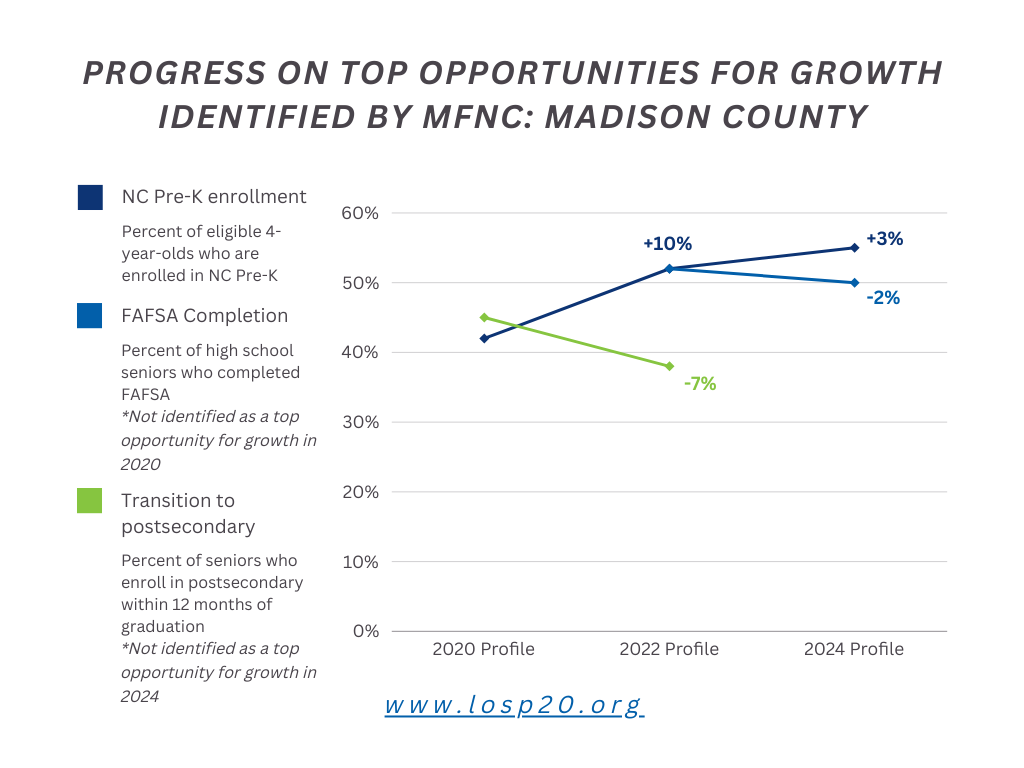
Transylvania County (rural - non-metro)
Transylvania County’s Top Opportunities for Growth (outlined in red in the image below) are Adult Learners, High School Graduation, and Transition to Postsecondary. The county’s performance was compared to the average performance of its peer counties for two of the indicators (Adult Learners and High School Graduation) and to the state average for the other indicator (Transition to Postsecondary).
Adult Learners
19% of Transylvania County adults ages 25-44 have some college, no degree, which is 3% above the rural – non-metro county average of 16%. All together, 54.1% of Transylvania County adults ages 25-44 have no degree or credential. This figure includes adult learners who have less than a high school education (7%) and those whose highest educational attainment was the completion of high school whether by graduating or earning a GED (28%). This means that 45.9% of Transylvania County adults ages 25-44 do have a degree or credential. This educational attainment rate is 4.1% below the 2030 educational attainment goal for Transylvania County (50%) that was set by myFutureNC.
High School Graduation
84% of Transylvania County 9th graders complete high school in 4 years or less, which is 1% below the rural – non-metro county average of 85%. Transylvania County’s High School Graduation rate of 84% is 11% below our 2030 High School Graduation goal of 95%.
Transition to Postsecondary
55% of Transylvania County seniors enroll in postsecondary within 12 months of graduation, below the state average of 58%. Transylvania County is 10% below our 2030 Transition to Postsecondary goal of 65% of high school graduates to enroll in a postsecondary institution within 12 months of graduation.
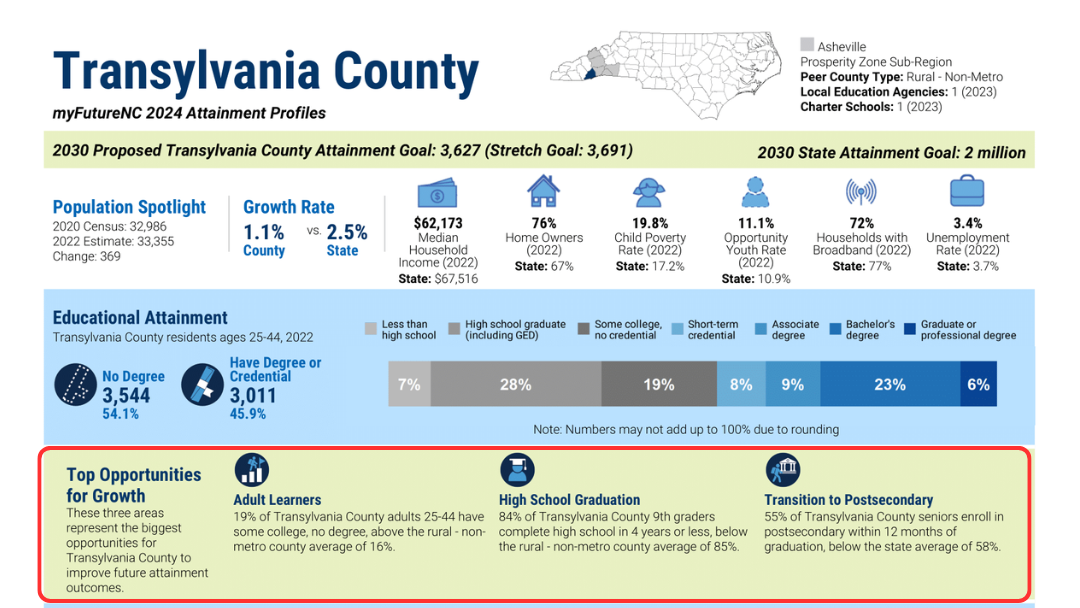
Transylvania County's Progress on Top Opportunities for Growth
Transylvania County has not had any Top Opportunities for Growth that were the same on all three attainment profiles (2020, 2022, and 2024). However, the county has had one indicator that was the same on the 2022 and 2024 profiles (High School Graduation). The High School Graduation rate remained flat at 84% on both the 2022 and 2024 attainment profiles.
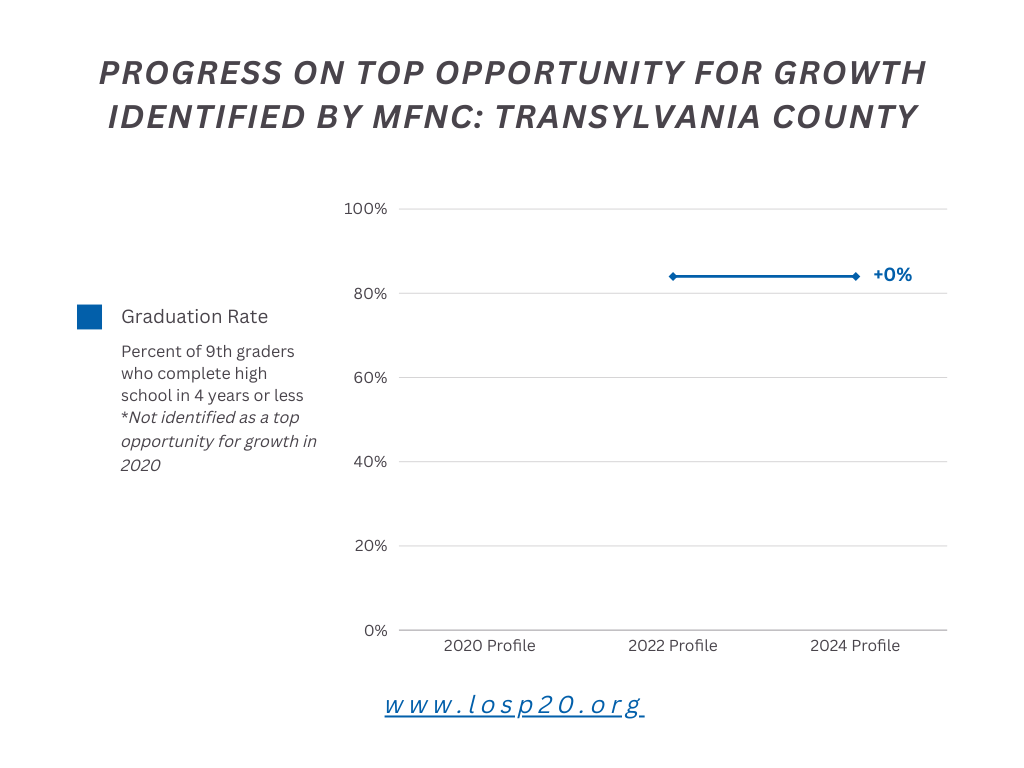
Top Opportunities for Growth for the Land of Sky Region
For our four counties, seven indicators were identified as Top Opportunities for Growth: Adult Learners, Chronic Absenteeism, Earning College Credit in High School, FAFSA Completion, High School Graduation, NC Pre-K Enrollment, and Transition to Postsecondary. None were identified for all four counties. Three of them (Chronic Absenteeism, Earning College Credit in High School, and High School Graduation) were identified for only one county. Let’s look at the remaining four in more detail.
Adult Learners
Two counties (Henderson and Transylvania) had Adult Learners as one of their Top Opportunities for Growth. According to the 2024 attainment profile for the Land of Sky region, 56.2% of adults ages 25-44 currently have a degree or credential. This rate is 18.5% below the 2030 goal set by myFutureNC of 74.7% for this region.
FAFSA Completion
A third indicator that was a Top Opportunity for Growth for two counties (Buncombe and Madison) is FAFSA Completion. Currently 60% of high school seniors in the region complete the FAFSA, according to the 2024 attainment profile for the Land of Sky region. As shown in the pictogram chart below, this rate is 20% below our 2030 goal of 80%, which is the second highest gap of these four Top Opportunities for Growth in our region.
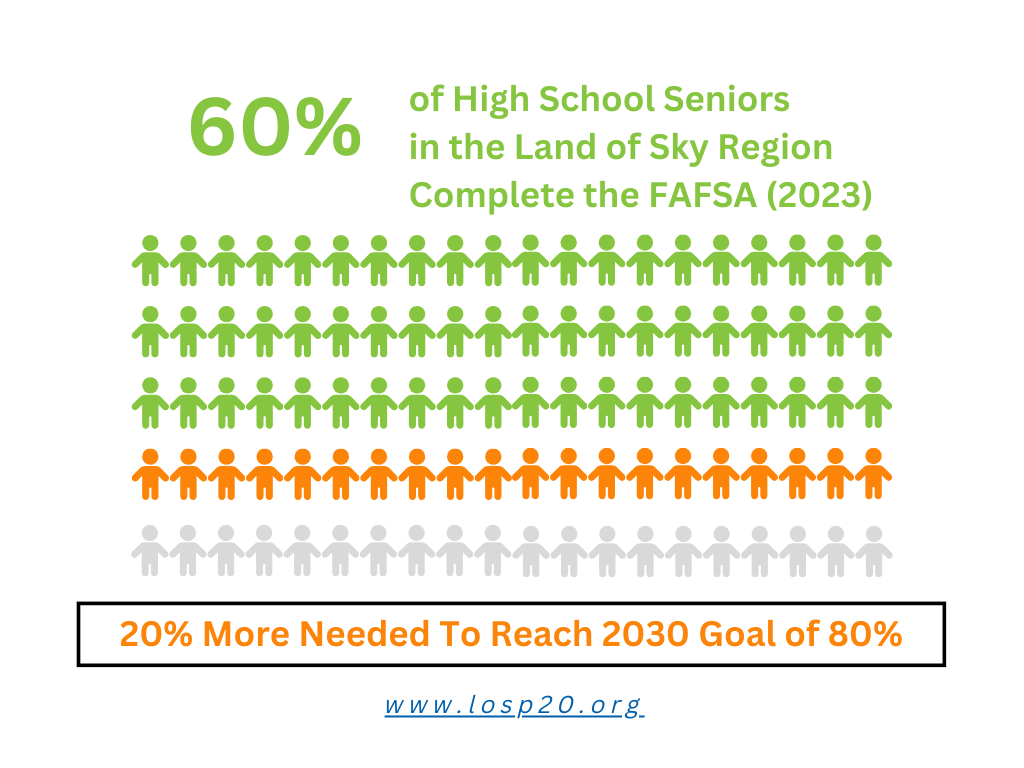
NC Pre-K Enrollment
The most prevalent Top Opportunity for Growth was NC Pre-K Enrollment, which was identified for three of our four counties (Buncombe, Henderson, and Madison). As a region, our NC Pre-K Enrollment rate is currently 44%, according to the Land of Sky region’s attainment profile for 2024. Of the four Top Opportunities for Growth in our region, this indicator has the largest gap (31%) between our current status and our 2030 goal (75%), which is depicted in the chart below.
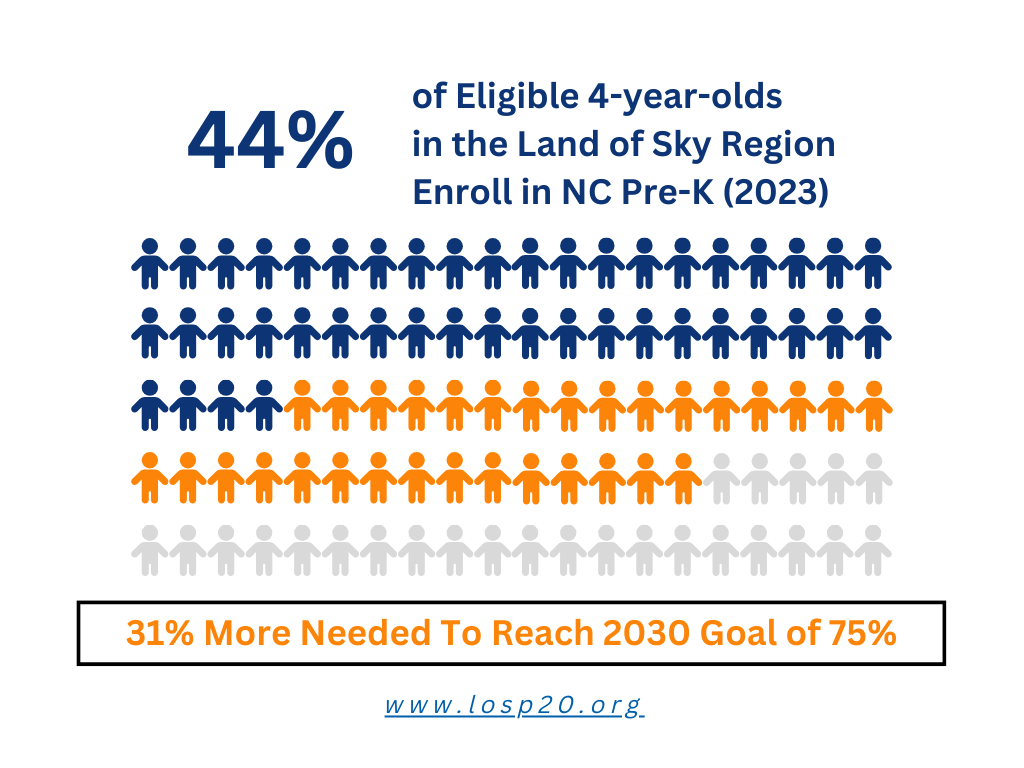
Transition to Postsecondary
Transition to Postsecondary was a Top Opportunity for Growth for two counties (Buncombe and Transylvania). The 2024 attainment profile for the Land of Sky region indicates that 54% of graduates enrolled in a postsecondary institution within 12 months. At 11% below our 2030 goal of 65%, the gap for this indicator is the smallest of the four regional Top Opportunities for Growth.
Land of Sky P20 Council's Efforts To Address Top Opportunities for Growth
For details on how specific indicators connect to our goals and how we are working to address them, please follow the links below:
- Adult Learners
- Chronic Absenteeism
- Earning College Credit in High School
- FAFSA Completion
- High School Graduation
- NC Pre-K Enrollment
- School Counselors
- Transition to Postsecondary
Stay tuned for more in this series. Next up: NC Opportunity Youth.


